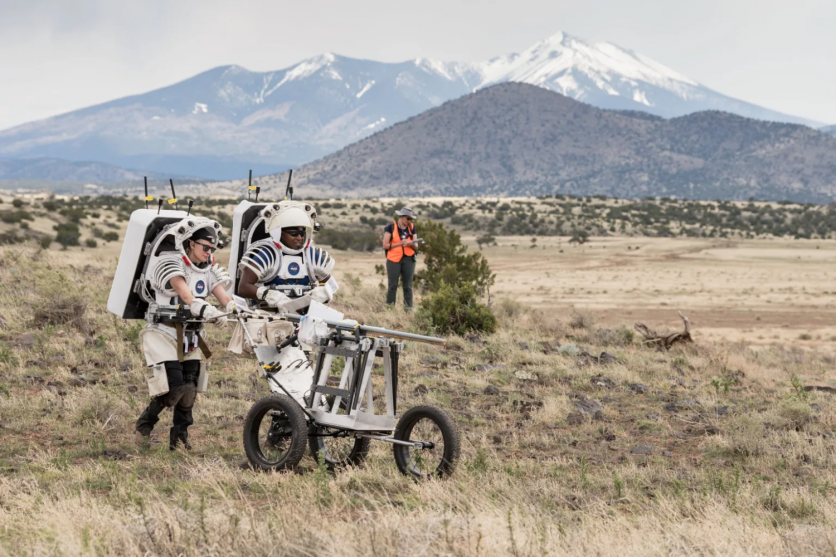A journey of a thousands steps (or rockets) to the moon starts in the desert. But why?
NASA is gearing up for lunar exploration under its Artemis campaign by conducting a week-long field test in the San Francisco Volcanic Field near Flagstaff, Arizona.

NASA Gears Up for the Moon on the Arizona Desert
The Arizona desert's lunar-like landscape provides an ideal setting to practice moonwalk scenarios, a crucial component of preparing for future missions to the Moon.
The field test involves NASA astronauts Kate Rubins and Andre Douglas, who are simulating moonwalks while wearing mockup spacesuit systems.
Throughout the test, they are engaged in various activities, including technology tests, hardware checkouts, and Artemis science operations in the desert terrain, according to NASA.
The testing process is designed to simulate end-to-end lunar operations, involving integrated teams working together across different locations. The field team will comprise astronauts, NASA engineers, and field experts to conduct simulated moonwalks in Arizona.
Meanwhile, a team of flight controllers and scientists from the space agency's Johnson Space Center in Houston will track and guide their activities remotely.
The field test encompasses four simulated moonwalks aligned with Artemis III mission operations and six advanced technology demonstrations.
These advanced runs showcase technology that could be deployed in future Artemis missions, such as heads-up displays leveraging augmented reality for navigation and lighting beacons to ensure the crew could return to the lander.
Before the field test, the science team at Johnson, responsible for establishing science objectives, undertook a rigorous planning process akin to Artemis missions.
This preparation will encompass generating geologic maps, identifying science questions, and prioritizing moonwalk locations for primary and backup landing sites.
Read Also : China Looks to be the First Nation to Retrieve Samples from Moon's Previously Unexplored Areas
Lunar South Pole Operations
NASA notes that the test ultimately aims to address gaps and challenges that could arise with lunar South Pole operations. The tests will focus on data collection, communication protocols, and rapid decision-making between Houston's flight control and science teams.
Following each simulated moonwalk, the teams involved in the test will gather to discuss lessons learned and record observations. These insights will inform operational strategies for NASA's Artemis missions, commercial vendor development, and ongoing technology advancements.
This field test is the fifth in a series led by the Joint Extravehicular Activity and Human Surface Mobility Test Team at Johnson. According to NASA, it builds upon previous simulations and marks the high-fidelity Artemis moonwalk mission simulation to date.
The Arizona desert has served as a training ground for lunar exploration since the Apollo era due to its resemblance to lunar terrain, featuring craters, faults, and volcanic features. The insights gained from these field tests contribute to NASA's preparations for deep space missions.
As part of the Artemis program, NASA plans to send the first female astronaut, the first astronaut of color, and its first international partner astronaut to the Moon, laying the groundwork for sustained lunar exploration and facilitating future missions to Mars.
Related Article : The First Non-Americans to Land on the Moon Will be Japanese as NASA, JAXA Sign Agreement for Lunar Rover

ⓒ 2026 TECHTIMES.com All rights reserved. Do not reproduce without permission.




